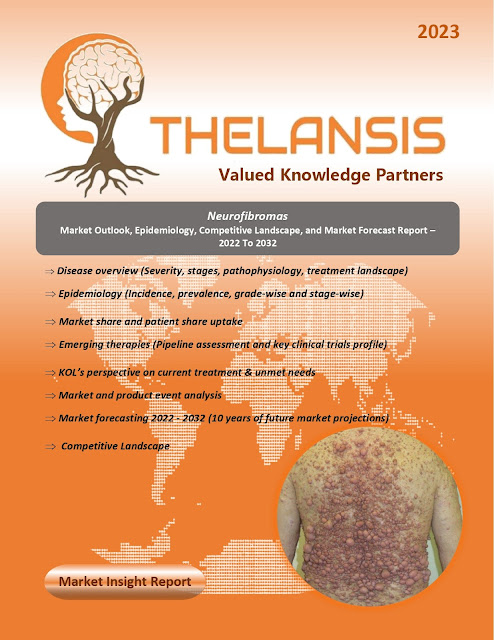Neurofibromas – Market Outlook, Epidemiology, Competitive Landscape, and Market Forecast Report – 2022 To 2032
Neurofibromas are benign nerve sheath tumors composed of differentiated neoplastic Schwann cells and a mixture of nonneoplastic components. These tumors can present as nodular and well-demarcated or diffuse growths. Intraneural neurofibromas typically grow along the nerve confined within its epineurium. The main cellular constituents of neurofibromas are neoplastic Schwann cells, characterized by small, curved, or elongated nuclei, along with fibroblasts embedded within a myxoid/collagenic matrix in varying proportions. While neurofibromas may exhibit focal resemblance to Antoni B pattern, they lack Antoni A pattern and hyalinized blood vessels, distinguishing them from schwannomas. The Schwann cell component in neurofibromas shows expression of S100 and SOX10 proteins. Both sporadic and syndromic neurofibromas are associated with a deletion in the NF1 gene. Sporadic cases only involve the lesional cells carrying the NF1 mutation, while syndromic cases result from a germline mutation in NF1, which encodes the tumor suppressor protein neurofibromin, located on chromosome 17q11.2. Diagnosing solitary superficial neurofibromas involves physical examination or excisional biopsy with microscopic examination. For larger lesions, additional imaging with CT/MRI is required to assess the extent of involvement and plan for surgical excision. Complete surgical excision is the preferred treatment for most cases, with an exceedingly low rate of local recurrence. Currently, there are no alternative therapies available for cutaneous neurofibromas. In rare instances in which complete surgical excision is not feasible for diffuse or plexiform neurofibromas, partial resection may be performed for cosmetic or symptomatic relief. All types of neurofibromas are benign, and the risk of malignant transformation is exceedingly low. However, around 10% of patients with NF1 may experience malignant transformation, emphasizing the importance of considering NF1 for any patient presenting with a plexiform neurofibroma. Plexiform neurofibromas are the most common precursor to malignant peripheral nerve sheath tumors (MPNSTs). Complications related to localized neurofibromas are typically mild and primarily associated with surgical excision, including pain, scarring, bleeding, and local infection. In plexiform lesions, complications arise from the inherent risks of surgery and the possibility of incomplete lesion removal. Patients with NF1 who have persistent lesions are at an increased risk of malignant transformation to malignant peripheral nerve sheath tumors (MPNSTs).
·
Neurofibromatosis type 1 (NF1) accounts for
approximately 96% of all neurofibromatosis cases, with a prevalence of 1 in
3000 births. It occurs equally between genders and races, and 50% of cases are
associated with spontaneous mutations, while the other half has an inherited
mutation. NF1 exhibits a 100% penetrance with variable expressivity.
·
Neurofibromatosis type 2 (NF2) makes up around
3% of cases, with a prevalence between 1 in 33,000 births and 1 in 87,410. NF2
does not show gender or race predilection and presents variable manifestations
among different families.
Thelansis’s “Neurofibromas Market
Outlook, Epidemiology, Competitive Landscape, and Market Forecast Report – 2022
To 2032" covers disease overview, epidemiology, drug utilization,
prescription share analysis, competitive landscape, clinical practice,
regulatory landscape, patient share, market uptake, market forecast, and key
market insights under the potential Neurofibromas treatment modalities options
for eight major markets (USA, Germany, France, Italy, Spain, UK, Japan, and
China).
KOLs insights
of Neurofibromas across 8 MM market from the centre of Excellence/ Public/
Private hospitals participated in the study. Insights around current treatment
landscape, epidemiology, clinical characteristics, future treatment paradigm,
and Unmet needs.
Neurofibromas Market Forecast Patient
Based Forecast Model (MS. Excel Based Automated Dashboard), which Data Inputs
with sourcing, Market Event, and Product Event, Country specific Forecast
Model, Market uptake and patient share uptake, Attribute Analysis, Analog
Analysis, Disease burden, and pricing scenario, Summary, and Insights.
Thelansis Competitive Intelligence (CI) practice
has been established based on a deep understanding of the pharma/biotech
business environment to provide an optimized support system to all levels of
the decision-making process. It enables business leaders in forward-thinking
and proactive decision-making. Thelansis supports scientific and commercial
teams in seamless CI support by creating an AI/ ML-based technology-driven
platform that manages the data flow from primary and secondary sources.




Comments
Post a Comment